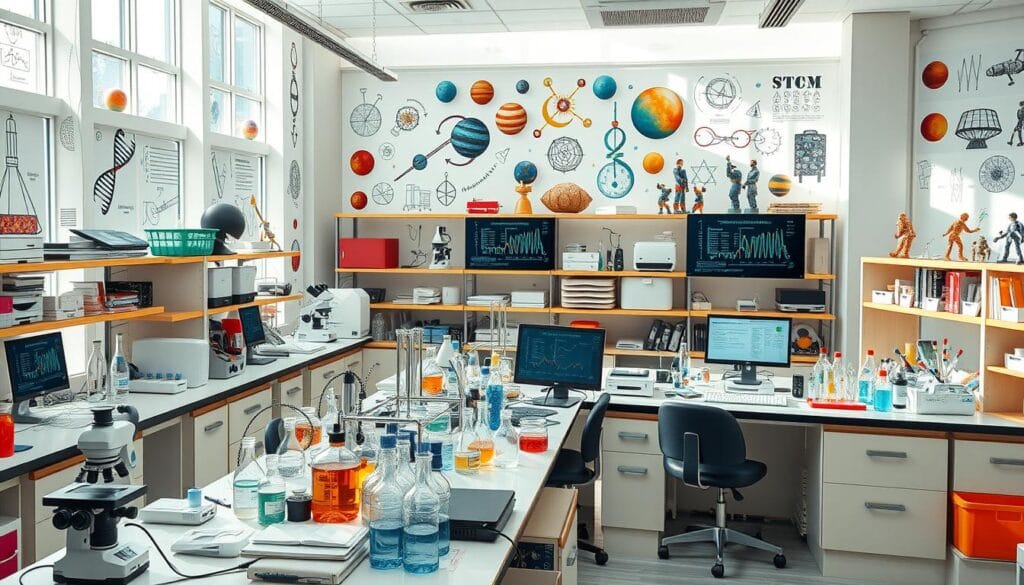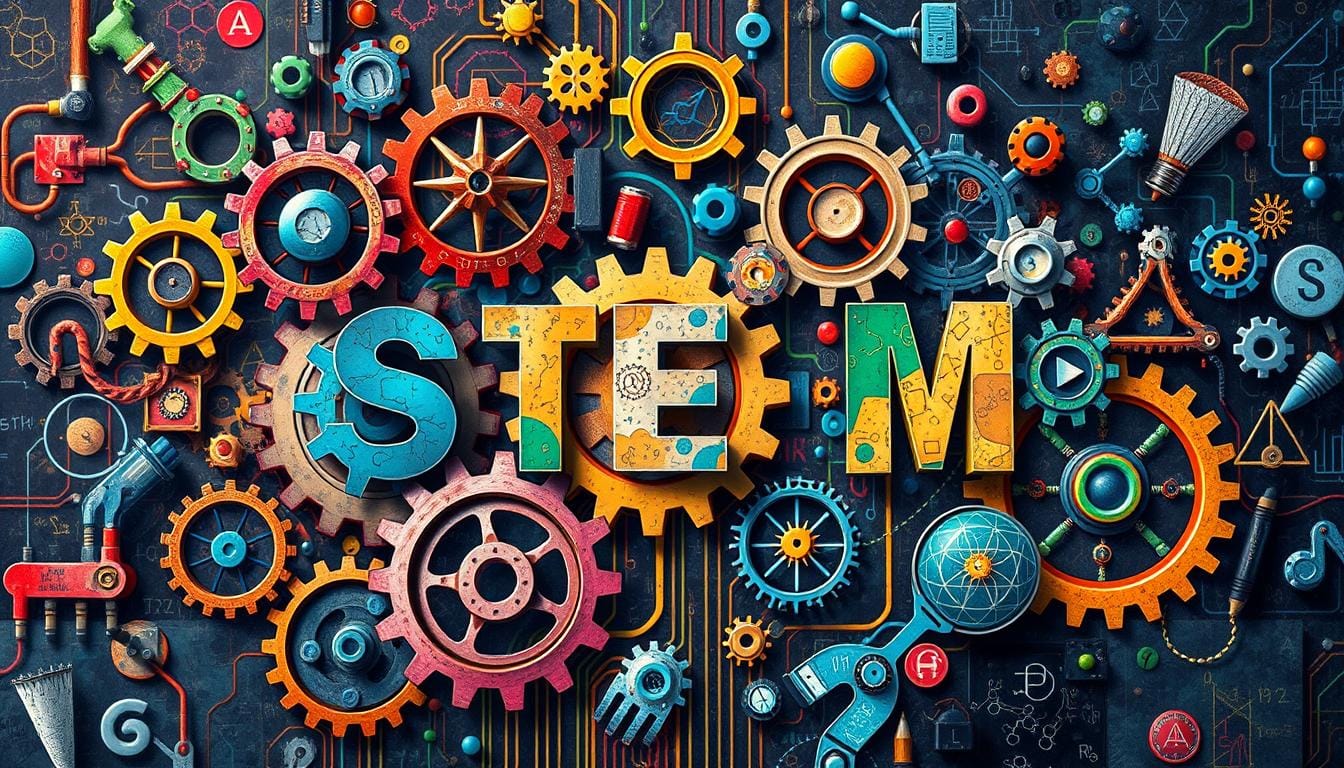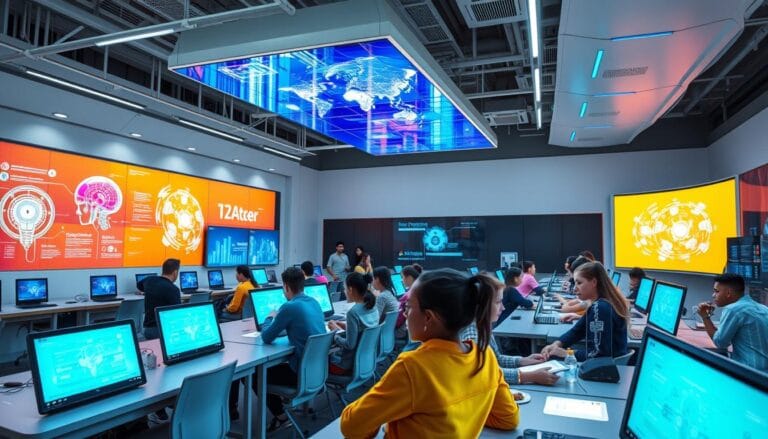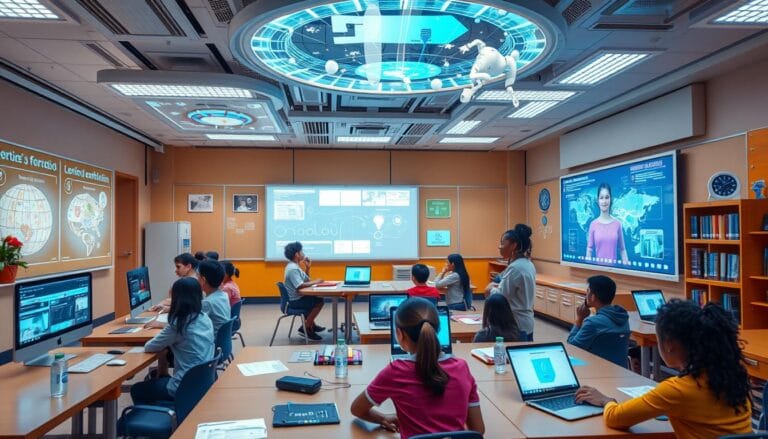STEM Writing Prompts: 50 Genius Prompts to Ask AI for Creative Inspiration
I’ve always been excited about how creativity meets innovation. The world of science, technology, engineering, and mathematics is full of possibilities. But, it can be hard to start writing about it all.
Thank you for reading this post, don't forget to subscribe!STEM writing prompts can change that. They open up new ways to explore and discover. This guide will show you how AI-generated prompts can spark your creative STEM-inspired ideas.
These prompts are for anyone who loves to learn and explore. Students, teachers, and curious minds will find them inspiring. They encourage you to think differently and see the endless possibilities in STEM.
Table of Contents
Key Takeaways
- STEM writing prompts unlock new avenues for creativity and innovation in scientific, technological, engineering, and mathematical fields.
- AI-generated prompts offer a unique and powerful tool for exploring cutting-edge ideas and pushing the boundaries of STEM exploration.
- Engaging with STEM writing prompts can enhance critical thinking, problem-solving, and interdisciplinary skills.
- Prompt-based writing exercises can inspire new research projects, design challenges, and conceptual breakthroughs.
- Leveraging STEM prompts can help you overcome writer’s block and find fresh perspectives on complex topics.
Understanding the Power of AI-Generated STEM Prompts
AI-generated prompts can really boost your STEM writing. They offer new and challenging ideas. This helps you explore fresh concepts, make new connections, and find creative solutions to tough problems.
By using AI, you can explore the latest in STEM fields. It lets you dive into cutting-edge topics.
Benefits of Using AI for STEM Writing
AI writing tools can do a lot, from sparking ideas to helping with research. They can:
- Spark new perspectives and uncover fresh insights
- Explore interdisciplinary connections within STEM disciplines
- Streamline your writing process and boost productivity
- Access a vast knowledge base to inform your research and writing
How AI Enhances Creative Thinking in STEM
AI prompts challenge your usual thinking and encourage new approaches. By working with these prompts, you can:
- Broaden your understanding of STEM-related concepts
- Generate unique ideas that challenge the status quo
- Combine diverse ideas and perspectives to create innovative solutions
- Develop a more adaptable and open-minded approach to problem-solving
Getting Started with AI Writing Tools
Exploring AI writing tools is a great way to improve your STEM writing and thinking. Here’s how to start:
- Familiarize yourself with top AI-generated prompts tools like ChatGPT, Copilot, and Gemini
- Learn how to craft effective prompts to get the best from the AI
- Try out the tools and see how they spark your STEM writing
- Use the insights and ideas from the AI in your work
Embracing AI-generated prompts can open up a world of creativity and innovation in STEM writing. Start exploring today. See how these tools can change your STEM writing and creative thinking.
Technology Writing Prompts
- AI’s Impact on Daily Life by 2050
Imagine how artificial intelligence will change our lives by 2050. Think about how it will be used in homes, workplaces, and public areas. Will AI assistants become our main friends? How will it change education, healthcare, travel, and how we interact with others?Consider both the good and bad sides, like ethical issues or too much reliance on AI. - Inventing a Global Problem-Solving Technology
If you could make one big technology to solve a global problem, what would it be? Describe its purpose, how it works, and its impact. Could it help with climate change, poverty, or health worldwide? How would you make sure it’s fair and not misused? - Ethical Dilemmas of Self-Driving Cars
Self-driving cars will soon be common, but they raise big ethical questions. What if a car has to choose between saving a pedestrian or its passengers in an accident? How should these choices be made, and who decides? Think about how society will change with self-driving cars. - Cybersecurity and National Security
Cybersecurity is key to keeping our country safe, our secrets secure, and our data protected. Talk about big cyberattacks, their effects, and how to stop them. What challenges do countries face in fighting new threats, and how can working together improve security? - Designing an Accessibility App
Picture creating an app to help people with disabilities. What features would it have for different needs? How would you make sure it’s inclusive by listening to users? Discuss the challenges of making technology that fits everyone’s needs. - Living in a Completely Virtual World
Imagine a world where virtual reality is everything. Describe your life in this digital world. How do people keep their identity and purpose? Think about the good and bad of living in a digital world, like mental health and society. - Using Technology to Combat Misinformation
Propose new tech to fight fake news online. Could AI or blockchain help? Discuss the ethics of these solutions, like censorship and privacy. - The Future of Wearable Technology in Healthcare
Think about how wearable tech could change healthcare. What new health tools or implants might we see? How could they help detect diseases early, tailor treatments, and improve health outcomes? Talk about the challenges like keeping data safe and making sure everyone can access these technologies. - Dangers of Advanced Robotics and Mitigation Strategies
Look at the risks of advanced robots, like job loss and AI misuse. How can we balance progress with safety? Suggest ways to control robotics, ensure it’s used right, and address fears about losing control. - A World Without the Internet
Write a story about a world without the internet. Describe the chaos it causes in communication, business, health, and government. How would people adjust to this new world? Explore themes of resilience, innovation, and finding new ways to live without the internet.
Science Writing Prompts
- Designing a Sustainable Mars Ecosystem
Imagine you’re creating a sustainable Mars ecosystem for humans. You need to plan everything from soil to energy sources. What plants and animals could live there, and how will you keep the ecosystem balanced? - Reversing Climate Change Through Technology
Think of three tech innovations to reverse climate change. Explain their science, how to use them, and their effects on the planet. How can these technologies work together to fix our environment, and what problems might they face? - The Water Cycle Adventure
Start as a water molecule and tell your journey through the water cycle. You’ll go from evaporation to rain and back again. Share your story, including pollution’s impact and your role in life. - Explaining DNA to a 17th-Century Audience
Travel back to the 17th century to explain DNA. You can’t use modern terms, so use analogies from that time. Describe DNA’s structure and its role in passing traits to future generations. - Discovering a New Species
You’ve found a new species on a remote trip. Describe its looks, where it lives, what it eats, and how it behaves. How does it fit into its world, and what does this mean for science? - What If Gravity Was Halved?
Imagine Earth’s gravity is now half as strong. Think about how this would change our world. How would animals and humans adapt, and what new technologies would we need? - The Importance of Biodiversity
Biodiversity is key to healthy ecosystems. Use examples like coral reefs and rainforests to show why. What happens if we lose biodiversity, and how can we protect it? - A World Where Bacteria Become Intelligent
Picture a world where bacteria can talk to us. How would this change healthcare, farming, and science? Write a story about how these smart bacteria could help or hinder us. - Animal Adaptations in Extreme Environments
Look at how animals survive in harsh places like the poles or deep-sea vents. What special tricks do they use? How can we apply these to our own technology and buildings? - The Life Cycle of Plants in Zero Gravity
In space, plant growth would be different. How would plants adapt to grow in space? What challenges would they face, and how could we overcome them to grow food for astronauts?
Engineering Writing Prompts
- Designing an Earthquake-Resistant Bridge
Imagine you’re an engineer designing a bridge in a place prone to earthquakes. What materials and designs would you use to make it strong? You might consider seismic dampers, base isolation, or flexible joints. Think about the cost, environmental impact, and how long it will last. - Building a Machine to Clean Ocean Plastic
Imagine a machine to clean the oceans of plastic. It could use drones, large filters, or nanotechnology. How would it collect debris without harming sea creatures? What energy source would it use, and how would it deal with the plastic it collects? - Creating the Fastest Electric Car
Write a guide to making the world’s fastest electric car. You’ll need to think about aerodynamics, battery tech, and motors. How can you make it fast without sacrificing safety or the environment? Consider its uses beyond racing. - Integrating Renewable Energy into Power Grids
Look into adding solar, wind, and hydropower to our power grids. Discuss the hurdles of storing energy, keeping the grid stable, and managing peak demand. Offer new ideas like smart grids or local power systems for a smooth transition. - Engineering Skyscrapers in Deserts
Think about the challenges of building tall buildings in deserts. You’ll face extreme heat, sandstorms, water shortages, and energy needs. How can you use sustainable cooling, local materials, and renewable energy in your design? - Future Engineering Skills
Guess which skills will be key for engineers soon. With automation, AI, and green concerns, what skills will be needed? Talk about the importance of knowing many subjects, being flexible, and solving problems in a changing world. - Nanotechnology Revolutionizing Medicine
Imagine a world where nanobots do surgeries, fix tissues, or deliver medicine. How would this change healthcare, ethics, and access to care worldwide? - Redesigning a Sustainable City
Picture a greener, more sustainable city. You’ll need to think about using renewable energy, public transport, green spaces, and waste management. How can you involve the community to make sure it works for everyone and is good for the planet? - 3D Printing in Space Exploration
Look into how 3D printing can help space travel. It could make tools, homes, or parts for spacecraft on the Moon, Mars, or in space. What are the challenges of printing in space, and how can it reduce our need for Earth resources? - Inventing a Water Purification Device
Design a device to clean water in poor areas. It could use the sun, filters, or chemicals. Think about making it affordable, portable, and able to remove all kinds of pollutants.
Mathematics Writing Prompts
- A Mathematician Solving a Global Problem
Imagine a mathematician working on a big global challenge. This could be predicting the weather, making vaccines, or fighting cyber threats. Describe their work, the tools they use, and the emotions they feel.How does their work change the world? - Fibonacci Sequence in Nature
The Fibonacci sequence shows up in nature, like in sunflower seeds or spiral galaxies. It’s a mathematical pattern that appears often. Explain why it’s so common and its beauty and uses in science and design. - Probability in Sports and Gaming
Probability is key in sports, gambling, and video games. It helps teams make decisions and gamblers set bets. Use examples like basketball shots or poker to show how it works.How does knowing probability help in these areas? - A Mathematical Formula Saves the World
Imagine a mathematician finds a formula that saves us from disaster. It could predict a big event or solve a big problem. Tell the story of their discovery and the excitement of saving the world. - Prime Numbers and Cryptography
Prime numbers are vital in keeping our online data safe. They help create encryption, like RSA, which protects our communications. Explain how hard it is to break these codes and why they’re so important. - Fractals and the Natural World
Fractals help us understand nature, from snowflakes to blood vessels. They show up everywhere and inspire new ideas in tech, art, and science. Explore how fractals work and their impact. - A Debate on Infinity
Imagine a debate between Pythagoras and Zeno on infinity. How would they argue and what would they say? Add humor and wisdom to the discussion. - Geometry in Modern Architecture
Geometry is key in modern buildings, from tall skyscrapers to bridges. It helps in design, making things stable and beautiful. Explain how geometry makes buildings work and look good. - Chaos Theory Simplified
Chaos theory shows how small changes can lead to big differences. Use examples like weather or the butterfly effect. Why is it important and where does it apply? - Math Solving a Crime
Imagine math solving a crime. A detective might use stats to find a suspect or geometry to solve a crime scene. Build suspense as they solve the mystery.
Interdisciplinary STEM Writing Prompts
- A Unified STEM World Solving Crises
Imagine a world where scientists, technologists, engineers, and mathematicians work together to solve big problems. These could be climate change, pandemics, or food shortages. Describe how their teamwork leads to new solutions and what technologies or discoveries come out of it. Also, talk about the cultural shift needed for such unity. - A STEM-Focused Superhero
Create a superhero who uses STEM disciplines. They might use engineering to make gadgets, mathematics to predict things, biology to get better, and technology to connect worldwide. Write about their mission, challenges, and how they inspire others. - Engineers and Mathematicians Designing Renewable Energy
Imagine engineers and mathematicians working together to make renewable energy better. They could use math and engineering to design smarter solar panels, wind turbines, or wave energy converters. Discuss how their work could change society. - CRISPR’s Future in Engineering and Healthcare
Think about how CRISPR gene editing might be used in the future. It could help create organisms for cleaning the environment, personalized medicine, or bioengineered materials. Talk about the good and bad sides of these possibilities. - A Space Exploration Collaboration
Write a story about students from different STEM fields working on a space project. An engineer, biologist, programmer, and mathematician team up. Their skills help solve challenges like building a spacecraft, living on Mars, and decoding alien signals. - Math in Artificial Intelligence Programming
Explain how math is key in making artificial intelligence. Discuss how linear algebra, probability, and optimization algorithms are used. Tell a story where math helps an AI solve a real problem. - Virtual Reality in STEM Education
See how virtual reality (VR) can change STEM education. Students could do virtual dissections, experiment in zero-gravity labs, or see math concepts in 3D. Talk about how VR makes STEM more fun and accessible for everyone. - Biomimicry in Modern Engineering
Describe biomimicry, where engineers learn from nature to solve problems. Give examples like gecko adhesives, sharkskin for airplanes, or termite cooling systems. Discuss how biomimicry can change design and make things more sustainable. - STEM Fields Tackling Climate Change
Explain how STEM disciplines are connected in fighting climate change. Technologists can make better carbon capture tools, engineers design strong infrastructure, biologists restore ecosystems, and mathematicians model climate trends. Highlight the need for teamwork. - A STEM-Based Utopia
Imagine a world where STEM is the core of society. What innovations make life better? How does technology improve sustainability, education, and healthcare? Write about the challenges and values needed to keep this world balanced.
Science-Based Writing Prompts for Innovation
Science-based writing prompts can spark your creativity and inspire new ideas. They cover many scientific fields, like biology, chemistry, physics, and environmental science. These prompts encourage you to think about theoretical ideas and solve real-world problems.
These prompts are great for students, researchers, or anyone who loves science. They help improve your scientific knowledge, critical thinking, and ability to share complex ideas. They offer a chance to explore new ideas and find solutions for scientific innovation and research ideas.
- Imagine finding a new species of microorganism on another planet. Describe its unique features and possible uses.
- Design a green energy solution for a small island. Think about the island’s natural resources and the environment.
- Consider the ethics of using gene editing to cure genetic diseases. Weigh the benefits against the risks.
- Propose a new model for the atom, challenging the old ideas about tiny particles.
- Study how climate change affects a local ecosystem. Then, plan a way to reduce its impact and protect biodiversity.
By using these science writing prompts, you can boost your creativity and analytical skills. You’ll also help advance scientific knowledge. Let these prompts spark your imagination and fuel your passion for scientific innovation and research ideas.
| Prompt Type | Number of Prompts | Targeted Audiences |
|---|---|---|
| Biology | 23 | Elementary, Middle, and High School |
| Chemistry | 16 | Middle and High School |
| Physics | 19 | Middle and High School |
| Environmental Science | 18 | Middle and High School |
“Imagination is more important than knowledge. For knowledge is limited, whereas imagination embraces the entire world, stimulating progress, giving birth to evolution.”
– Albert Einstein
Use science writing prompts to tap into your creativity. Dive into the world of scientific innovation and find new research ideas that can change our future.
Technology and Digital Innovation Prompts
Explore the fast-changing world of technology and digital innovation with these prompts. They cover artificial intelligence (AI), robotics, virtual reality, and new technologies. These prompts help you understand today’s and tomorrow’s tech trends. They also make you think about the ethics of new tech.
Artificial Intelligence Scenarios
Imagine a day where a human works with an advanced AI. How do they work together? What problems or benefits come from their partnership? Or picture a world where AI robots are everywhere. Describe how humans and these robots interact and think about the social, economic, and ethical sides.
Future Technology Concepts
Picture a future with holographic talk, quantum computers, or nanotech. How would these techs change our lives in entertainment, education, health, and travel? Or write a persuasive essay on why a certain future tech is good or bad. Talk about its benefits and downsides.
Digital Ethics Explorations
Look into the ethics of new tech like facial recognition, online lies, or job automation. Write a story that makes you think about the moral and social effects of these techs. Or suggest rules or laws for the right use of these technologies.
These prompts are a fun and creative way to dive into digital innovation. By exploring AI, future tech, and digital ethics, you can boost your creativity and critical thinking. You’ll also get a better grasp of how tech and society interact.
Engineering Design Challenges and Scenarios
Engineering design challenges offer writers a chance to solve real-world problems. They cover many fields like mechanical, electrical, civil, and aerospace engineering. These prompts help writers think deeply, find new solutions, and share technical ideas clearly.
Here are 10 fun STEM challenges for kids to try at home. These activities use simple materials like marshmallows, toothpicks, and cardboard. They help kids learn basic engineering concepts.
- Tower Building Challenge (ages 5 and up): Build the tallest tower with marshmallows and toothpicks.
- Rubber Band Car (ages 8 and above): Make a car that moves with a rubber band and race it.
- Paper Airplane Competition (ages 6 and up): See whose paper airplane can fly the farthest.
- Pulley System Challenge (ages 7 and up): Make a pulley system to lift a weight with simple materials.
- Popsicle Stick Catapult (ages 8 and above): Create a catapult with popsicle sticks and rubber bands to launch objects.
These engineering writing prompts, design challenges, and problem-solving scenarios help kids learn important skills. They improve spatial awareness, fine motor skills, and understanding of engineering basics. These activities encourage creativity, critical thinking, and a love for STEM subjects.
“Engineering is not just about numbers and formulas; it’s about using your imagination to solve real-world problems.” – Anonymous
For more ideas, check out our 50 STEM writing prompts. They are perfect for educators, parents, or young engineers. These engineering writing prompts, design challenges, and problem-solving scenarios make STEM learning fun and engaging.
Mathematics and Problem-Solving Prompts
Explore the world of mathematics and problem-solving with exciting writing prompts. These prompts help you see how math applies to real life. They also improve your ability to solve problems and dive into data science.
Real-world Mathematical Applications
See how math meets everyday life. Write stories that show how math affects our world. This could be in city planning or nature’s patterns. Let your math skills shine and find beauty in numbers.
Data Science Story Starters
- Imagine a future where AI and machine learning change our decisions. Write about the good and bad sides of these changes.
- Follow a data analyst as they find new insights from a big dataset. Show how data can lead to new ideas.
- Picture a world where predictive analytics solve big problems. Describe how this tech helps with issues like climate change or health crises.
Quantitative Reasoning Exercises
Try solving math problems that are more than just homework. Create stories that mix real-life situations with math skills. This could be using stats, optimization, or algorithms. Show how to make complex math easy to understand.
“Writing to learn in math, science, and social studies ‘reliably enhanced learning’ with an effect size of 0.30.”
Use these writing prompts to explore math and problem-solving. They help you be more creative, improve your math skills, and see the connection between STEM and storytelling.
STEM Writing Prompts for Research Projects
Get ready to show off your STEM writing skills with our top picks of research prompts. Whether you’re diving into scientific inquiry, making hypotheses, or setting up new experiments, these prompts will spark your creativity. They’ll also help you push your STEM projects to new levels.
Dive into the exciting world of research writing prompts. Here, you’ll take on advanced STEM projects and explore scientific inquiry in depth. You’ll find questions that make you think differently and help you come up with innovative research ideas.
- Look into perovskites, a calcium-based mineral, as a green alternative for solar cells.
- Check how different personal protective equipment (PPE) stops respiratory viruses from spreading.
- See how lockdowns affect air quality and pollution in cities.
- Find out how contact tracing apps help control infectious diseases.
- Study how air pollution affects health and suggest new ways to lessen its impact.
| Research Area | Sample Research Topic |
|---|---|
| Biomedical Engineering | Wearable health devices and their potential in real-time health monitoring |
| Environmental Engineering | Innovative wastewater treatment systems to reduce environmental harm |
| Quantum Computing | Exploring the applications of quantum computing in solving complex problems faster |
| Aeronautical Engineering | Sustainable fuel alternatives for aircraft |
| Astrophysics | Investigating the implications of the cosmic microwave background for the Big Bang theory |
Unlock your full potential as a STEM researcher with these exciting writing prompts. Explore the latest in scientific discovery and find insights that will take your STEM projects to new heights.

“The beautiful thing about learning is that no one can take it away from you.” – B.B. King
Interdisciplinary STEM Story Ideas
Explore the mix of different STEM fields to spark your creativity. Interdisciplinary STEM story ideas let you blend concepts from various scientific and technological areas. This approach encourages innovative thinking and fresh perspectives.
Combining Multiple STEM Fields
Imagine a world where medical breakthroughs are powered by quantum computing algorithms. Or picture a future where renewable energy systems are designed using biomimicry. These prompts challenge you to merge diverse fields, such as:
- Robotics and neuroscience
- Biophysics and materials science
- Astrophysics and computer science
- Genetic engineering and data analytics
- Environmental science and aerospace engineering
Cross-disciplinary Innovation Prompts
Stretch your imagination with interdisciplinary STEM and cross-disciplinary innovation. Think of stories that mix scientific and technological disciplines in new ways. This can lead to innovative solutions for complex problems.
Explore multidisciplinary research, where different perspectives and expertise come together. This is where groundbreaking discoveries often happen.
| STEM Field | Interdisciplinary Connections | Potential Story Ideas |
|---|---|---|
| Biomedicine | Artificial Intelligence, Nanotechnology, Material Science | Nanorobots designed to deliver targeted cancer therapies |
| Renewable Energy | Biotechnology, Environmental Science, Civil Engineering | Algae-based biofuel powering sustainable urban infrastructure |
| Space Exploration | Aerospace Engineering, Computer Science, Astrophysics | Autonomous lunar habitats powered by advanced AI systems |
“The next generation of innovation will come from the intersection of diverse ideas and disciplines.”
Environmental Science and Sustainability Prompts
Unlock your creativity with our environmental writing prompts. These prompts help you explore big ecological issues. You’ll look into climate change solutions and sustainability ideas. You can write stories, research papers, or design plans for a greener future.
These prompts are for everyone, whether you’re a student, teacher, or environmental advocate. They make you think about how we affect nature. Imagine new energy sources, waste plans, or environmental justice stories. Your words can help make a difference.
- Imagine being a raindrop on a journey. Describe the places and people you meet, and how they change your path.
- Design a city powered by green energy. Talk about its buildings, transport, and community projects.
- Write a persuasive essay for a plastic waste reduction program in your area. Discuss its benefits and challenges.
- Look into how climate change can be tackled through citizen science. Suggest a project for your community.
- Imagine studying deforestation’s effect on a species. Share your research and what you’d tell policymakers to help.
| Environmental Science Topic | Prompt Idea |
|---|---|
| Renewable Energy | Imagine a community powered by green energy. Describe the tech, infrastructure, and community efforts. |
| Water Pollution | Be a water molecule in a polluted river. Describe the pollutants and human actions you see. |
| Biodiversity Conservation | Propose a protected area for a threatened species. Explain its ecological value, challenges, and management. |
Use environmental writing prompts to spark your creativity. They help you understand sustainability and fight climate change. Your writing can help protect our planet.
“The Earth has a kind of soul. It’s like a living, breathing thing. And we’re all part of it.” – Diane Ackerman
Biotech and Medical Innovation Scenarios
Biotechnology and medical innovation are changing healthcare fast. They bring us new ideas that were once science fiction. Writers can explore these ideas, like gene editing and personalized medicine, through biotech prompts.
These prompts let you think about the ethics of these new technologies. You can imagine how they might change medicine in the future.
Future Medicine Concepts
Imagine a world where we can edit genes to change human traits. This raises questions about creating “designer babies.” What are the good and bad sides of this technology?
Think about a future with nanobots in our blood, keeping us healthy. How would this change healthcare? And what challenges would there be in making sure everyone can access these treatments?
Genetic Engineering Narratives
Genetic engineering could change how we see life. Write stories about gene manipulation, like rebels fighting against genetic changes or rulers controlling the genome. Think about the surprises that could come from gene hacking.
Picture a world where the government forces everyone to get mood-stabilizing nanobots. Or imagine the first artificial womb that can grow babies outside the body.
| Biotech Writing Prompts | Genetic Engineering Narratives |
|---|---|
|
|
Exploring these ideas lets you challenge your creativity and think deeply about ethics. You can imagine how these advancements might change humanity.
Space Exploration and Astronomy Writing Prompts
Space exploration and astronomy writing prompts are exciting. They let you dive into the universe’s secrets. You can write about finding new planets, traveling through space, or searching for alien life.
These prompts help you learn about space and imagine the future. You can explore topics like exoplanets, space travel, and life beyond Earth.
The article lists 10 key astronomy topics. It covers astrophysical magnetism, neutron stars, and the Cosmic Microwave Background. It also talks about dark energy and dark matter’s effects on the universe.
There are 10 areas of research focus on stars, planets, and galaxies. This includes galaxy clusters and how they form.
Writing prompts for space and astronomy spark your creativity. They help you think of new ways to solve space travel and discovery challenges. Whether you’re interested in gravitational lensing, neutron stars, or exoplanets, these prompts are full of ideas for your writing.
FAQ
What are STEM writing prompts?
How can AI-generated prompts enhance STEM writing?
What types of science-based writing prompts are available?
How can technology and digital innovation prompts benefit writers?
What are engineering design challenges and scenarios?
How can mathematics and problem-solving prompts benefit writers?
What are STEM writing prompts for research projects?
What are interdisciplinary STEM story ideas?
What are environmental science and sustainability prompts?
What are biotech and medical innovation scenarios?
What are space exploration and astronomy writing prompts?
Source Links
- OpenAI API Documentation: Explore OpenAI’s API capabilities for creative AI applications, including Python programming challenges.
- Hallucination: (artificial intelligence)
- STEM programs
- WikipediaWorldwide Youth in Science and Engineering







